Solved Examples
Example 35.1
A wire placed along north-south direction carries a current of 10 A from south to north. Find the magnetic field due to a 1 cm piece of wire at a point 200 cm north-east from the piece.
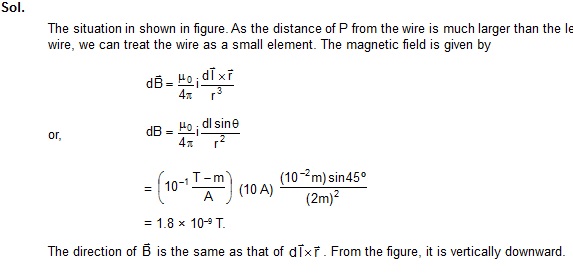
Example 35.2
Figure shows two long, straight wire carrying electric currents in opposite directions. The separation between the wires is 5.0 cm. Find the magnetic field at a point P midway between the wires.

Exercise 35.3
Two long, straight wires, each carrying an electric current of 5.0 A, are kept parallel to each other at a separation of 2.5 cm. Find the magnitude of the magnetic force experienced by 10 cm of a wire.
Sol.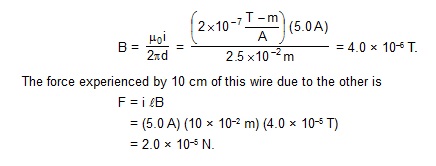
Example 35.4
A circular coil of radius 1.5 cm carries a current of 1.5 A. If the coil has 25 turns, find the magnetic field at the centre.
Sol. The magnetic field at the centre due to each turn is
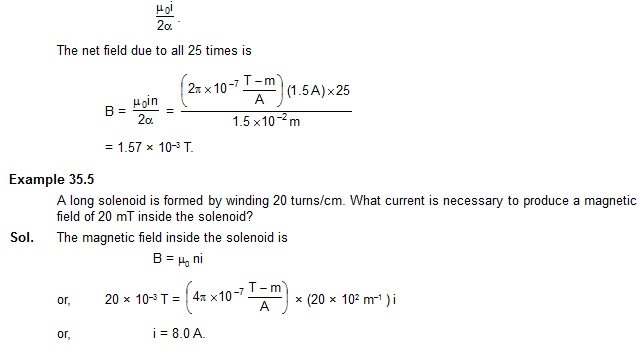
Questions for Short answer
1. An electric current flows in a wire from north to south. What will be the direction of the magnetic field
due to this wire at a point east of the wire ? West of the wire ? Vertically above the wire ? Vertically below the wire?
![]()
3. You are facing a circular wire carrying an electric current. The current is clockwise as seen by you.
Is the field at the centre coming towards you or going away from you ?
![]()
mean that the magnetic field B calculated by using Ampere's law, gives the contribution of only the currents crossing the area bounded by the curve ?
5. The magnetic field inside a tightly wound, long solenoid is B = m0ni. It suggests that the field does not depend on the total length of the
solenoid the field should not increase. Explain qualitatively why the extra–added loops do not have a considerable effect on the field inside the solenoid.
6. A long, straight wire carries a current. Is Ampere's law valid for a loop that does not enclose the wire ? That encloses the wire but is not circular ?
7. A straight wire carrying an electric current is placed along the axis of a uniformly charged ring. Will there be a magnetic force on the wire if the
ring starts rotating about the wire ? If yes, in which direction ?
8. Two wires carrying equal currents i each, are placed perpendicular to each other, just avoiding a contact. If one wire is held fixed and the other is
free to move under magnetic forces, what kind of motion will result ?
9. Two proton beams going in the same direction repel each other whereas two wires carrying currents in the same direction attract each other. Explain.
10. In order to have a current in a long wire, it should be connected to a battery or some such device. Can we obtain the magnetic field due to a straight,
long wire by using Ampere's law without mentioning this other part of the circuit ?
11. Quite often, connecting wires carrying currents in opposite directions are twisted together in using electrical appliances. Explain how it unwanted magnetic field.
12. Two current–carrying wires may attract each other. In absence of other forces, the wires will move towards each other increasing the kinetic energy.
Does it contradict the fact that the magnetic force cannot do any work and hence cannot increase the kinetic energy ?
Objective - I
1. A vertical wire carries a current in upward direction. An electron beam sent horizontally towards the wire will be deflected
(A) towards right (B) towards left (C*) upwards (D) downwards
2. A current-carrying, straight wire is kept along the axis of a circular loop carrying a current. The straight wire
(A) will exert an inward force on the circular loop
(B) will exert an outward force on the circular loop
(C*) will not exert any force on the circular loop
(D) will exert a force on the circular loop parallel to itself.
3. A proton beam is going from north to south and an electron beam is going from south to north. Neglection the earth’s magnetic field, the electron beam will be deflected
(A*) towards the proton beam (B) away from the proton beam
(C) upwards (D) downwards
4. A circular loop is kept in that vertical plane which contains the north-south direction. It carries a current that is towards north at the topmost point.
Let A be a point on axis of the circle to the east of it and B a point on this axis to the west of it. The magnetic field due to the loop
(A) is towards east at A and towards west at B
(B) is towards west at A and towards east at B
(C) is towards east at both A and B
(D*) is towards west at both A and B
5. Consider the situation shown in fig. The straight wire is fixed but the loop can move under magnetic force. The loop will -

(A) remain stationery (B*) move towards the wire
(C) move away from the wire (D) rotate about the wire
6. A charge particle is moved along a magnetic field line. The magnetic force on the particle is
(A) along its velocity (B) magnetic field only (C) both of them (D*) none of them
7. A moving charge produces
(A) electric field only (B) magnetic filed only (C*) both of them (D) none of these
8. A particle is projected in a plane perpendicular to a uniform magnetic field. The area bounded
by a the path described by the particle is proportional to
(A) the velocity (B) the momentum (C*) the kinetic energy (D) none of these
9. Two particles X and Y having equla charge, after being acceleration through the same potential difference circular paths of radii R1
and R2 respectively. The ratio of the mass of X to that of Y is -
(A) (R1/R2)1/2 (B) R1/R2 (C*) (R1/R2)2 (D) R1R2
10. Two parallel wires carry currents of 20 A and 40 A in opposite directions. Another wire carrying a current antiparallel to 20
A is placed midway between the two wires. The magnetic force on it will be
(A) towards 20 A (B*) towares 40 A (C) zero (D) perpendicular to the plane of the current

(A) 4 (B) 3 (C*) 2 (D) 1
12. Consider a long, straight wire of cross-section area A carrying a current i.Let there be n free electrons per unit
volume. An observer places himself on a trolley moving in the direction opposite to the current with a speed
u = (i/nAe) and separated from the wore bu a distance r. The magnetic field seen by the observer is very nearly

Objective - II

(A*) x, y have the same dimensions. (B*) y, z have the same dimensions
(C*) z, x have the same dimensions (D) None of the three pairs have the same dimensions
3. A long, straight wire carries a current along the Z-axis. One can find two points in the X-Y plane such that
(A) the magnetic fields are equal
(B*) the directions of the magnetic fields are the same
(C*) the magnitudes of the magnetic fields are equal
(D*) the field at one point is opposite to that at the other point
4. A long, straight wire of radius R carries a current distrobuted uniformly over its cross-section. The magnitude of the magnetic field is
(A) maximum at the axis of the wire (B*) minimum at the axis of the wire
(C*) maximum at the surface of the wire (D) minimum at the surface of the wire.
5. A hollow tube is carrying an electric current along its length distributed uniformly over its surface. The magnetic field
(A) increases linearly from the axis to the surface (B*) is constant inside the tube
(C*) is zero at the axis (D) is zero just outside the tube
6.In a coaxial, straight cable, the central conductor and the outer conductor carry equal currents in opposite directions. The magnetic field is zero.
(A*) outside the cable (B) inside the inner conductor
(C) inside the outer conductor (D) in between the two conductors.
7. A steady electric current is flowing through a cylindrical conductor.
(A) the electric field at the axis of the conductor is zero
(B*) the magnetic field at the axis of the conductor is zero
(C*) the electric field in the vicinity of the conductor is zero
(D) the magnetic field in the vidinity of the conductor is zero
Worked Out Examples
1. Two long wires a and b, carrying equal currents of 10.0 A, are placed parallel to each other with a separation of 4.00 cm
between them as shown in figure. Find the magnetic field B at each of the points P, Q and R.

Its direction will be perpendicular to the line shown and will point downward in the figure. The field at this point due to the other wire has magnitude
Similarly, the resultant magnetic field at R will be = 1.33 × 10–4 T along the direction pointing upward in the figure.
The magnetic field at point Q due to the two wires will have equal magnitudes but opposite directions and hence the resultant field will be zero.
2. Two parallel wires P and Q placed at a separation d = 6 cm carry electric currents i1 = 5A and i2 = 2A in opposite directions as shown in figure (a).
Find the point on the line PQ where the resultant magnetic field is zero.


Sol. At the desired point, the magnetic fields due to the two wires must have equal magnitude but opposite directions.
The point should be either to the left of P or to the right of Q. As the wire Q has smaller current, the point should be
closer to Q. Let this point R be at a distance x from Q (figure (b)).
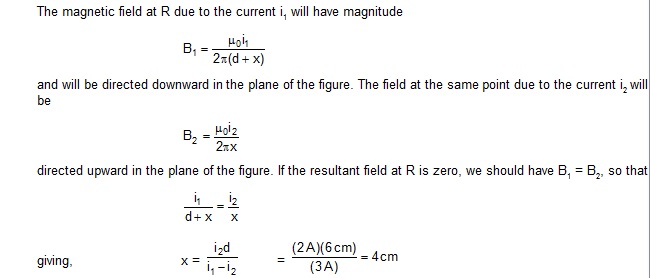
3. Two long, straight wires a and b are 2.0 m apart, perpendicular to the plane of the paper as shown in figure.
The wire a carries a current of 9.6 A directed into the plane of the figure. The magnetic field at the point p at a
distance of 10/11 metre from the wire b is zero. Find (a) the magnitude and direction of the current in b,
(b) the magnitude of the magnetic field B at the point s and (c) the force per unit length on the wire b.

Sol. (a) For the magnetic field at p to be zero, the current in the wire b should be coming out of the plane of the
figure so that the fields due to a and b may be opposite at p. The magnitude of these fields should be equal, so that

or, i = 3.0 A
(b) (ab)2 = 4m2
(as)2 = 2.56 m 2
and (bs)2 = 1.44 m 2
so that (ab) 2 = (as) 2 + (bs) 2 and angle asb = 90º. The field at s due to the wire a
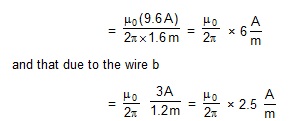
These fields are at 90º to each other so that their resultant will have a magnitude
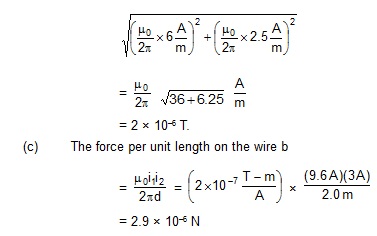
4. A current of 2.00 A exists in a square loop of edge 10.0 cm. Find the magnetic field B at the centre of the square loop.
Sol. The magnetic fields at the centre due to the four sides will be equal in magnitude and direction. The field due to one side will be
![]()
Here, a = 10 cm and d = a/2 = 5 cm.
Thus,
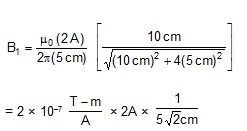
= 5.66 × 10–6 T.
Hence, the net field at the centre of the loop will be
4 × 5.66 × 10–6 T = 22.6 × 10–6 T.
5. Figure shows a square loop made from a uniform wire. Find the magnetic field at the centre of the square if a battery is connected between the points A and C.
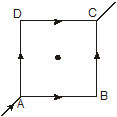
Sol. The current will be equally divided at A. The fields at the centre due to the currents in the wires AB and DC will be equal in
magnitude and opposite in direction. The resultant of these two fields will be zero. Similarly, the resultant of the fields due to
the wires AD and BC will be zero. Hence, the net field at the centre will be zero.
6. Two long wires, carrying currents i1 and i2, are placed perpendicular to each other in such a way that they just avoid a contact.
Find the magnetic force on a small length dl of the second wire situated at a distance l from the first wire.
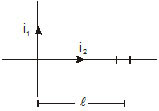
Sol. The situation is shown in figure. The magnetic field at the site of dl, due to the first wire is ,

This force is parallel to the current i1.
7. Figure shows a part of an electric circuit. ABCD is a rectangular loop made of uniform wire. The length AD = BC = 1 cm.
The sides AB and DC are long as compared to the other two sides. Find the magnetic force

per unit length acting on the figure DC due to the wire AB if the ammeter reads 10 A.
Sol. By symmetry, each of the wires AB and DC carries a current of 5 A. As the separation between them is 1 cm,
the magnetic force per unit length of DC is

8. Figure shows a current loop having two circular arcs joined by two radial lines. Find the magnetic field B at the centre Q.
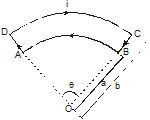
Sol. As the point O is on the line AD, the magnetic field at O due to AD is zero. Similarly, the field at O due to BC

9. Find the magnetic field at the point P in figure. The curved portion is a semicircle and the straight wire are long.

Sol. The magnetic field at P due to any current element in the figure is perpendicular to the plane of the figure and
coming out of it. The field due to the upper straight wire is


10. The magnetic field B due to a current-carrying circular loop of radius 12 cm at its centre is 0.50 × 10–4 T.
Find the magnetic field due to this loop at a point on the axis at a distance of 5.0 cm from the centre.
Sol. The magnetic field at the centre of a circular loop is
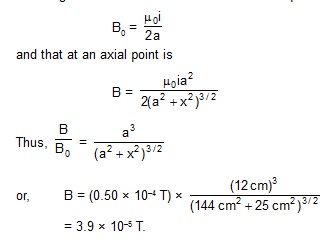
11. Consider a coaxial cable which consists of an inner wire of radius a surrounded by an outer shell of inner and
outer radii b and c respectively. The inner wire carries an electric current i0 and the outer shell carries an equal
current in opposite direction. Find the magnetic field at a distance x from the axis where (a) x < a, (b) a < x < b
(c) b < x < c and (d) x > c. Assume that the current density is uniform in the inner wire and also uniform in the outer shell.
Sol.
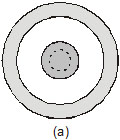
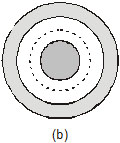
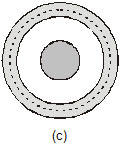
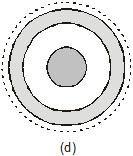
A cross-section of the cable is shown in figure. Draw a circle of radius x with the centre at the axis of the cable.
The parts a, b, c and d of the figure correspond to the four parts of the problem. By symmetry, the magnetic field
at each point of a circle will have the same magnitude and will be tangential to it. The circulation of B along this circle is, therefore,
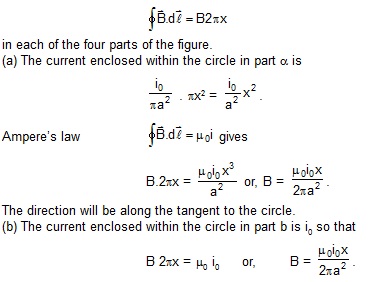
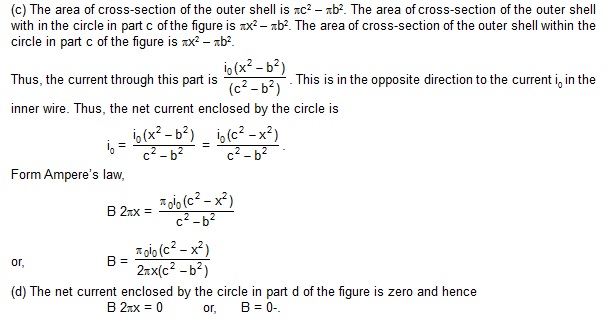
12. Figure shows a cross-section of a large metal sheet carrying an electric current along its surface. The current in a strip
of width\ dl is Kdl where K is a constant. Find the magnetic field at a point P at a distance x from the metal sheet.

Sol. Consider two strips A and C of the sheet situated symmetrically on the two sides of P (figure). The magnetic field at P due to
the strip A is B0 perpendicular to AP and that due to the strip C is BC perpendicular to CP. The resultant of these two is parallel
to the width AC of the sheet. The field due to the whole sheet will also be in this direction. Suppose this field has magnitude B.
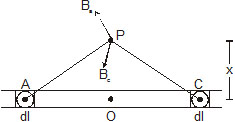
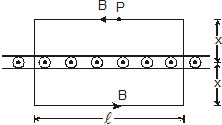
The field on the opposite side of the sheet at the same distance will also be B but in opposite direction. Applying
Ampere’s law to the rectangle shown in figure.

13. Consider the situation described in the previous example. A particle of mass m having a charge q is placed at a distance
d from the metal sheet and is projected towards it. Find the maximum velocity of projection for which the particle does not hit the sheet.
Sol. As the magnetic field is uniform and the particle is projected in a direction perpendicular to the field, it will describe a circular path.
The particle will not hit the metal sheet. If the radius of this circle is smaller than d. For the maximum velocity, the radius is just equal to d. Thus.
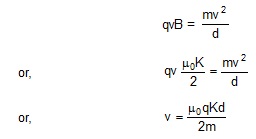
14. Three identical long solenoids P, Q and R are connected to each other as shown in figure. If the magnetic field at the centre of
P is 2.0 T, what would be the field at the centre of Q? Assume that the field due to any solenoid is confined within the volume
of that solenoid only.

![]()